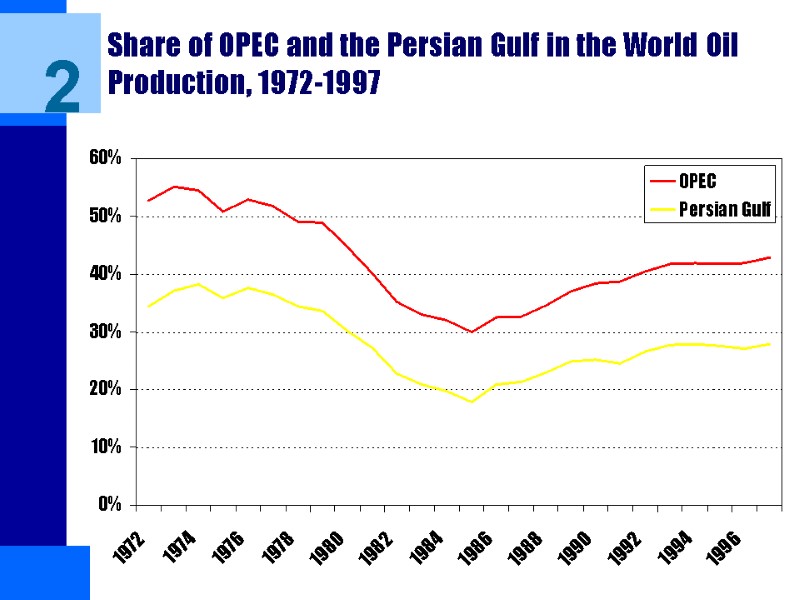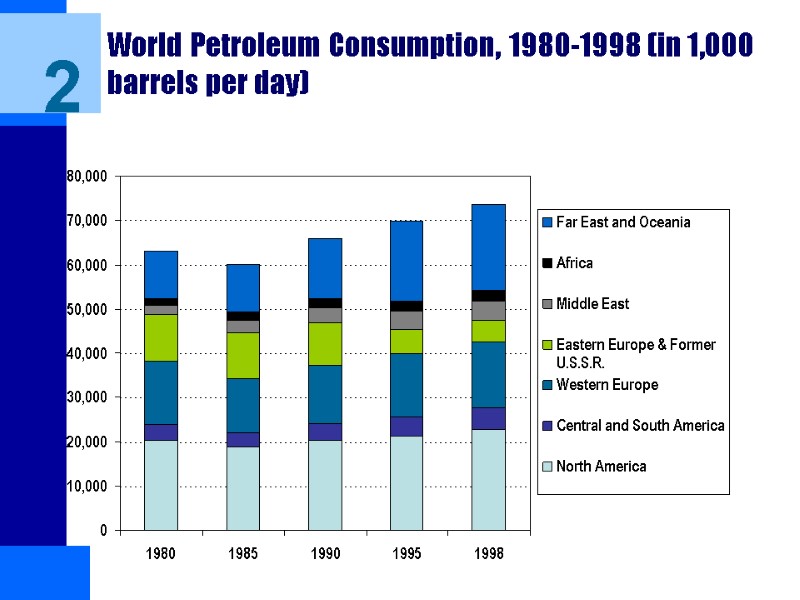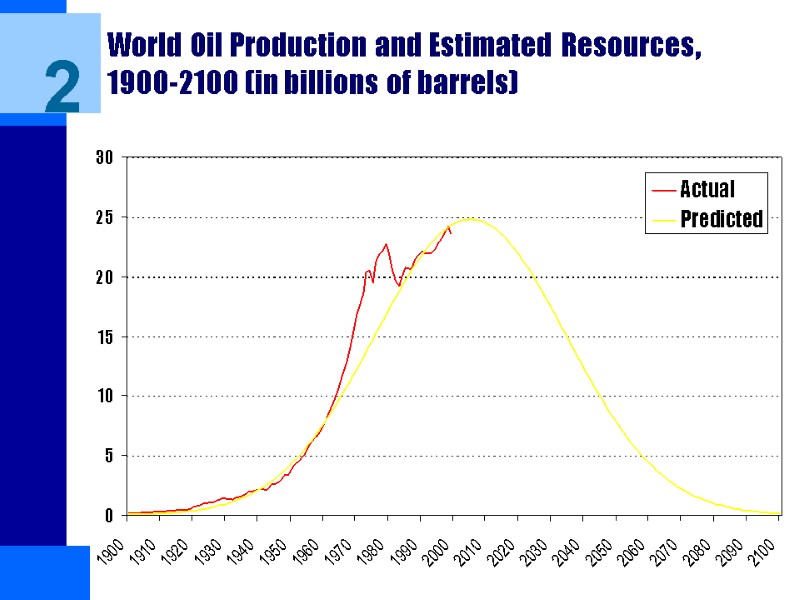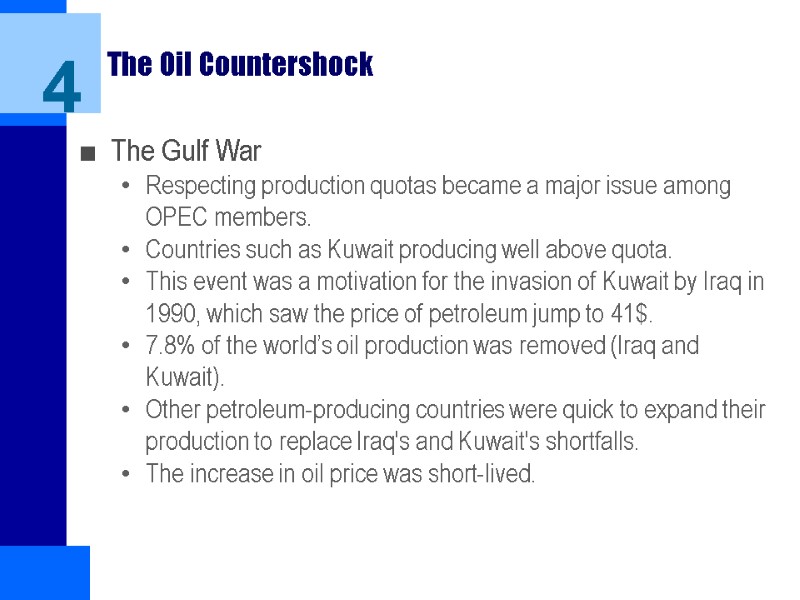Case Study 9 – The Geopolitics of Petroleum




































8588-geog_102_case_study_9.ppt
- Количество слайдов: 35
 Case Study 9 – The Geopolitics of Petroleum 1 – Context 2 – The Economic Importance of Petroleum 3 – First and Second Oil Shocks 4 – The Oil Countershock
Case Study 9 – The Geopolitics of Petroleum 1 – Context 2 – The Economic Importance of Petroleum 3 – First and Second Oil Shocks 4 – The Oil Countershock
 1 Context The Seven Sisters Petroleum has for long been the object of geopolitical confrontations. The ability to fix the price and the production of oil was first established in 1928 by the Achnacarry Agreements. Between the “seven sisters” forming an oil oligopoly. Major oil multinationals (Exxon, Texaco, British Petroleum, Shell, Gulf, Standard Oil and Mobil Oil). Invested massively in extraction infrastructures, especially in the Middle East. Several producing countries, most of them in the Third World, wanted to have a more important share of the incomes of this lucrative market.
1 Context The Seven Sisters Petroleum has for long been the object of geopolitical confrontations. The ability to fix the price and the production of oil was first established in 1928 by the Achnacarry Agreements. Between the “seven sisters” forming an oil oligopoly. Major oil multinationals (Exxon, Texaco, British Petroleum, Shell, Gulf, Standard Oil and Mobil Oil). Invested massively in extraction infrastructures, especially in the Middle East. Several producing countries, most of them in the Third World, wanted to have a more important share of the incomes of this lucrative market.
 Context OPEC Venezuela, Iran, Iraq, Saudi Arabia and Kuwait founded the Organization of Petroleum Exporting Countries (OPEC) in 1960 at the Baghdad conference. Several other oil-producing nations joined thereafter the organization: Qatar (1961), Indonesia (1962), Libya (1969), Algeria (1970), Nigeria (1971), Ecuador (1973-1992, left the organization in order to avoid production quotas), The United Arab Emirates (1973) and Gabon (1973-1994). From its foundation until the beginning of the 1970s, OPEC was unable to increase oil prices. Production was very important in non-member countries. Difficulty of OPEC members to agree on a common policy. 1
Context OPEC Venezuela, Iran, Iraq, Saudi Arabia and Kuwait founded the Organization of Petroleum Exporting Countries (OPEC) in 1960 at the Baghdad conference. Several other oil-producing nations joined thereafter the organization: Qatar (1961), Indonesia (1962), Libya (1969), Algeria (1970), Nigeria (1971), Ecuador (1973-1992, left the organization in order to avoid production quotas), The United Arab Emirates (1973) and Gabon (1973-1994). From its foundation until the beginning of the 1970s, OPEC was unable to increase oil prices. Production was very important in non-member countries. Difficulty of OPEC members to agree on a common policy. 1
 OPEC Country Former member of OPEC Venezuela Ecuador Nigeria Gabon Algeria Libya Saudi Arabia Iraq Iran Indonesia Kuwait Qatar United Arab Emirates OPEC Countries 1
OPEC Country Former member of OPEC Venezuela Ecuador Nigeria Gabon Algeria Libya Saudi Arabia Iraq Iran Indonesia Kuwait Qatar United Arab Emirates OPEC Countries 1
 Context Developed countries were confident that the price of petroleum would remain relatively stable. The American Government even predicted that the oil price might rise to 5 dollars a barrel by 1980. Environment of low petroleum prices and strong economic growth. No developed country had an energy policy and waste was common. 1
Context Developed countries were confident that the price of petroleum would remain relatively stable. The American Government even predicted that the oil price might rise to 5 dollars a barrel by 1980. Environment of low petroleum prices and strong economic growth. No developed country had an energy policy and waste was common. 1
 The Economic Importance of Petroleum Context First commercial exploitations in Pennsylvania in 1859. Importance of oil increased significantly in the global economy. In 1920, 95 million tons were produced annually. Number reached 500 million tons by 1950. A billion tons in 1960. Average annual production around 3 billion tons in the 1990s. Strong growth rests for a very large part on the availability of oil resources and their low cost. Economic systems, which include industry, housing, energy generation and transportation, became dependant on cheap oil prices. The United States being the most eloquent example. 2
The Economic Importance of Petroleum Context First commercial exploitations in Pennsylvania in 1859. Importance of oil increased significantly in the global economy. In 1920, 95 million tons were produced annually. Number reached 500 million tons by 1950. A billion tons in 1960. Average annual production around 3 billion tons in the 1990s. Strong growth rests for a very large part on the availability of oil resources and their low cost. Economic systems, which include industry, housing, energy generation and transportation, became dependant on cheap oil prices. The United States being the most eloquent example. 2
 The Economic Importance of Petroleum The relationships between oil supply and demand A spatial differentiation of supply and demand. This can only be overcome by oil transportation. 42% of the oil production was controlled by OPEC in 1997. Countries not being OPEC members contributed to 58% of the production. A spatial differentiation of oil reserves is also observed, the bulk of them, 64%, are located in the Middle East Estimates in reserves range from 50 to 100 years. 2
The Economic Importance of Petroleum The relationships between oil supply and demand A spatial differentiation of supply and demand. This can only be overcome by oil transportation. 42% of the oil production was controlled by OPEC in 1997. Countries not being OPEC members contributed to 58% of the production. A spatial differentiation of oil reserves is also observed, the bulk of them, 64%, are located in the Middle East Estimates in reserves range from 50 to 100 years. 2
 Share of OPEC and the Persian Gulf in the World Oil Production, 1972-1997 2
Share of OPEC and the Persian Gulf in the World Oil Production, 1972-1997 2
 World Energy Consumption, 1990-2020 1
World Energy Consumption, 1990-2020 1
 World Crude Oil Production, 1980-1998 (in 1,000 barrels per day) 2
World Crude Oil Production, 1980-1998 (in 1,000 barrels per day) 2
 World Petroleum Consumption, 1980-1998 (in 1,000 barrels per day) 2
World Petroleum Consumption, 1980-1998 (in 1,000 barrels per day) 2
 World Oil Balance, 1980-1998 (in 1,000 barrels per day) 2
World Oil Balance, 1980-1998 (in 1,000 barrels per day) 2
 World Oil Production and Estimated Resources, 1900-2100 (in billions of barrels) 2
World Oil Production and Estimated Resources, 1900-2100 (in billions of barrels) 2
 Estimates of Ultimate Oil Resources (billions of barrels) 2
Estimates of Ultimate Oil Resources (billions of barrels) 2
 World Crude Oil Reserves, 1999 2
World Crude Oil Reserves, 1999 2
 Major Crude Oil Reserves, 1999 (billions of barrels) 2
Major Crude Oil Reserves, 1999 (billions of barrels) 2
 The Economic Importance of Petroleum Costs of oil dependency Wealth is transferred from oil consumers to producers. The economy’s overall ability to produce is reduced by oil’s greater economic scarcity. When price movements are sudden and drastic, inflation and unemployment cause additional losses of output. Creates instability. 2
The Economic Importance of Petroleum Costs of oil dependency Wealth is transferred from oil consumers to producers. The economy’s overall ability to produce is reduced by oil’s greater economic scarcity. When price movements are sudden and drastic, inflation and unemployment cause additional losses of output. Creates instability. 2
 Middle East North America Latin America Africa Western Europe Former Soviet Union Pacific Asia Major Oil Shipping Routes 2
Middle East North America Latin America Africa Western Europe Former Soviet Union Pacific Asia Major Oil Shipping Routes 2
 3 The First Oil Shock Control In the 1970s, OPEC countries achieved control over more than 55% of the oil supply. Started to fix production quotas. Establish co-operation between producers in order to avoid competition that would bring the price of oil down. Feasible in the context of a growing market demand and the dependency on only a few oil suppliers. Very difficult to maintain in a competitive environment. Between 1970 and 1973, the price of the oil barrel passed from 1.80 dollars to 3.01 dollars.
3 The First Oil Shock Control In the 1970s, OPEC countries achieved control over more than 55% of the oil supply. Started to fix production quotas. Establish co-operation between producers in order to avoid competition that would bring the price of oil down. Feasible in the context of a growing market demand and the dependency on only a few oil suppliers. Very difficult to maintain in a competitive environment. Between 1970 and 1973, the price of the oil barrel passed from 1.80 dollars to 3.01 dollars.
 The First Oil Shock The Kippur War of 1973 Between Israel and Egypt (and several other Arabian countries). OPEC intervened by nationalizing production facilities, reducing production by 25% and imposing export quotas. OPEC imposed quotas on countries supporting Israel. The price of oil consequently reached 11.65 dollars per barrel at the end of the same year. High oil demand, the limited capacity of developed countries to supply oil and no readily energetic substitutes. OPEC gained the ability to control the price of oil with a market controlled by oil producers. This caused the first oil shock. 3
The First Oil Shock The Kippur War of 1973 Between Israel and Egypt (and several other Arabian countries). OPEC intervened by nationalizing production facilities, reducing production by 25% and imposing export quotas. OPEC imposed quotas on countries supporting Israel. The price of oil consequently reached 11.65 dollars per barrel at the end of the same year. High oil demand, the limited capacity of developed countries to supply oil and no readily energetic substitutes. OPEC gained the ability to control the price of oil with a market controlled by oil producers. This caused the first oil shock. 3
 The Second Oil Shock The 1970s and early 1980s The price of oil remained high but stable over the 1970s, around 20 dollars per barrel. Developed countries started to worry about the exhaustion of oil reserves and unreliable supply sources. Instability in two major oil producers, Iran and Iraq. The Iranian revolution of 1979. Iran-Iraq War of 1979-1980, because Iran was trying to export the Islamic revolution to Iraq. Removed 8% of the world oil supply. Caused the second oil shock where the price of oil went over 35 dollars per barrel. 3
The Second Oil Shock The 1970s and early 1980s The price of oil remained high but stable over the 1970s, around 20 dollars per barrel. Developed countries started to worry about the exhaustion of oil reserves and unreliable supply sources. Instability in two major oil producers, Iran and Iraq. The Iranian revolution of 1979. Iran-Iraq War of 1979-1980, because Iran was trying to export the Islamic revolution to Iraq. Removed 8% of the world oil supply. Caused the second oil shock where the price of oil went over 35 dollars per barrel. 3
 The Second Oil Shock Drastic, but somewhat temporary, measures to lower oil consumption. Relocation of energy-consuming industries. Consuming less energy in a more efficiently manner. Relying on national energy sources (petroleum, coal, natural gas, hydroelectricity, nuclear energy. Substituting petroleum for other energy sources when possible. 3
The Second Oil Shock Drastic, but somewhat temporary, measures to lower oil consumption. Relocation of energy-consuming industries. Consuming less energy in a more efficiently manner. Relying on national energy sources (petroleum, coal, natural gas, hydroelectricity, nuclear energy. Substituting petroleum for other energy sources when possible. 3
 The Oil Countershock A changing scene At the end of the 1980s and at the beginning of the 1990s, OPEC countries lost their price-fixing power. Internal problems (economic and geopolitical conflicts between its members). New producers such as Russia, Mexico, Norway, England and Colombia. Not constrained by OPEC policies and were free to fix their own prices. Mexico surpassed Saudi Arabia in 1997 to become the second largest oil exporter to the United States, after Venezuela. Latin American countries such as Columbia and Brazil are trying to boost their oil production. 4
The Oil Countershock A changing scene At the end of the 1980s and at the beginning of the 1990s, OPEC countries lost their price-fixing power. Internal problems (economic and geopolitical conflicts between its members). New producers such as Russia, Mexico, Norway, England and Colombia. Not constrained by OPEC policies and were free to fix their own prices. Mexico surpassed Saudi Arabia in 1997 to become the second largest oil exporter to the United States, after Venezuela. Latin American countries such as Columbia and Brazil are trying to boost their oil production. 4
 The Oil Countershock Vietnam is exploring offshore fields, as are other Southeast Asian countries, hopeful that there are major reserves under the South China Sea. Divergences Since 1982, divergences occurred within OPEC members to fix quotas and prices as competition increased. The share of OPEC dropped from 55% of all the petroleum exported in the 1970s to 41% in 1992. All-time low of 30% in 1985. That year Saudi Arabia lowered the price of its oil to increase its market share. Oil counter-shock that lowered the price of the barrel under 20 dollars, even reaching a record of 15 dollars in 1988. The oil market was again a market controlled by the demand. 4
The Oil Countershock Vietnam is exploring offshore fields, as are other Southeast Asian countries, hopeful that there are major reserves under the South China Sea. Divergences Since 1982, divergences occurred within OPEC members to fix quotas and prices as competition increased. The share of OPEC dropped from 55% of all the petroleum exported in the 1970s to 41% in 1992. All-time low of 30% in 1985. That year Saudi Arabia lowered the price of its oil to increase its market share. Oil counter-shock that lowered the price of the barrel under 20 dollars, even reaching a record of 15 dollars in 1988. The oil market was again a market controlled by the demand. 4
 The Oil Countershock The Gulf War Respecting production quotas became a major issue among OPEC members. Countries such as Kuwait producing well above quota. This event was a motivation for the invasion of Kuwait by Iraq in 1990, which saw the price of petroleum jump to 41$. 7.8% of the world’s oil production was removed (Iraq and Kuwait). Other petroleum-producing countries were quick to expand their production to replace Iraq's and Kuwait's shortfalls. The increase in oil price was short-lived. 4
The Oil Countershock The Gulf War Respecting production quotas became a major issue among OPEC members. Countries such as Kuwait producing well above quota. This event was a motivation for the invasion of Kuwait by Iraq in 1990, which saw the price of petroleum jump to 41$. 7.8% of the world’s oil production was removed (Iraq and Kuwait). Other petroleum-producing countries were quick to expand their production to replace Iraq's and Kuwait's shortfalls. The increase in oil price was short-lived. 4
 The Oil Countershock Aftermath of the Gulf War The price of oil fell to 25 dollars per barrel by the mid 1990s. By 1998, the price of petroleum went under 10 dollars per barrel. Rendering several producing regions temporarily unprofitable. OPEC countries only control about 42% of the global oil production and are so in a weak position to fix prices. Reemergence At the end of the 1990s, the price of petroleum increased. Oil reserves are in the Middle East. Share of OPEC expected to climb to 48% in 2005 and 52% in 2010. 4
The Oil Countershock Aftermath of the Gulf War The price of oil fell to 25 dollars per barrel by the mid 1990s. By 1998, the price of petroleum went under 10 dollars per barrel. Rendering several producing regions temporarily unprofitable. OPEC countries only control about 42% of the global oil production and are so in a weak position to fix prices. Reemergence At the end of the 1990s, the price of petroleum increased. Oil reserves are in the Middle East. Share of OPEC expected to climb to 48% in 2005 and 52% in 2010. 4
 Real Price of Oil, 1914-1995 and Major Disruptions in World Oil Supply 4
Real Price of Oil, 1914-1995 and Major Disruptions in World Oil Supply 4
 Petroleum Imports and Oil Price, USA, 1960-1996 4
Petroleum Imports and Oil Price, USA, 1960-1996 4
 United States Strategic Petroleum Reserves, 1977-1999 4
United States Strategic Petroleum Reserves, 1977-1999 4
 Gasoline Prices, 1978-2000 U.S., Germany, Japan (constant 1995 dollars per gallon) 4
Gasoline Prices, 1978-2000 U.S., Germany, Japan (constant 1995 dollars per gallon) 4
 A Sound Energy Policy Safe supply sources Low diversity of energy sources. Foreign sources. Dependence on oil. Keeping natural resources for future use. Low oil prices instead of an energy policy. Reasonable prices Economies of scale. Waste involves less profits. Market forces and profit margins. Low environmental consequences Lobbying against environmental legislation. 4
A Sound Energy Policy Safe supply sources Low diversity of energy sources. Foreign sources. Dependence on oil. Keeping natural resources for future use. Low oil prices instead of an energy policy. Reasonable prices Economies of scale. Waste involves less profits. Market forces and profit margins. Low environmental consequences Lobbying against environmental legislation. 4
 Cost of Gasoline, United States, 1999 4
Cost of Gasoline, United States, 1999 4
 Natural Gas Production, 1980-1998 (trillion BTUs) 3
Natural Gas Production, 1980-1998 (trillion BTUs) 3
 World Gas Reserves, 2000
World Gas Reserves, 2000
 Natural Gas Reserves and Production, 2003
Natural Gas Reserves and Production, 2003

